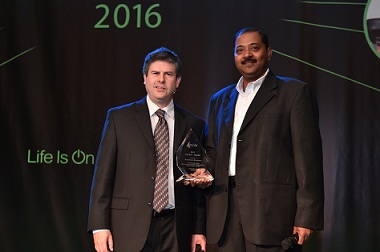 exida, the global leader in functional safety and cybersecurity certification for the process industries has certified three Schneider Electric product development sites in Foxboro, Mass., Worthing, U.K., and Hyderabad, India, for compliance with the exida Security Development Lifecycle certification based on IEC 62443-4-1. exida is a globally recognized ISO 17065 accredited Certification Body (CB) in cybersecurity.
exida, the global leader in functional safety and cybersecurity certification for the process industries has certified three Schneider Electric product development sites in Foxboro, Mass., Worthing, U.K., and Hyderabad, India, for compliance with the exida Security Development Lifecycle certification based on IEC 62443-4-1. exida is a globally recognized ISO 17065 accredited Certification Body (CB) in cybersecurity.
The three certified Schneider Electric sites utilize a product development lifecycle that includes cybersecurity considerations in all phases of new product development, demonstrating an institutionalized commitment to securing industrial automation and control systems (IACS).
“As IT and OT converge, more technology is connecting with more technology; more people are connecting with more technology; more people are connecting with more people. All this connectivity is driving an influx of data that can be very beneficial to control system operators and engineers, but it all has to be secured first,” said Andy Kling, director of Process Automation cybersecurity and software practices, Schneider Electric. “This certification acknowledges our commitment to addressing safety and cybersecurity concerns head on to ensure our customers can take advantage of all the benefits of a connected, modern plant. We are pleased to work with exida and other industry-leading organizations, and look forward to continuing and strengthening our relationship with them so we can all meet continuous, rigorous cybersecurity demands.”
“Schneider Electric has a strong, industry-leading product development process and they built upon that to add the requirements of exida’s cybersecurity program,” said Dr. William Goble, exida managing director. “They treated the cybersecurity issue very seriously and created a process that will help them avoid hacker attacks.”
 Mike Medoff, exida senior safety engineer presented the 2015 exida Safety Award in the Cybersecurity Category to Schneider Electric recognizing their Process Automation Cybersecurity Development Process. The presentation was delivered at Connect 2016, Schneider Electric’s Automation Conference on May 24, 2016 in New Orleans, LA.
Mike Medoff, exida senior safety engineer presented the 2015 exida Safety Award in the Cybersecurity Category to Schneider Electric recognizing their Process Automation Cybersecurity Development Process. The presentation was delivered at Connect 2016, Schneider Electric’s Automation Conference on May 24, 2016 in New Orleans, LA.
 exida, the global leader in functional safety and cybersecurity certification for the process industries has certified three Schneider Electric product development sites in Foxboro, Mass., Worthing, U.K., and Hyderabad, India, for compliance with the exida Security Development Lifecycle certification based on IEC 62443-4-1. exida is a globally recognized ISO 17065 accredited Certification Body (CB) in cybersecurity.
exida, the global leader in functional safety and cybersecurity certification for the process industries has certified three Schneider Electric product development sites in Foxboro, Mass., Worthing, U.K., and Hyderabad, India, for compliance with the exida Security Development Lifecycle certification based on IEC 62443-4-1. exida is a globally recognized ISO 17065 accredited Certification Body (CB) in cybersecurity. Siemens has opened its "Cyber Security Operation Center" (CSOC) for the protection of industrial facilities, with a joint location in Lisbon and Munich and one in Milford (Ohio) in the USA. Siemens industrial security specialists based at these sites monitor industrial facilities all around the world for cyber threats, warn companies in the event of security incidents and coordinate proactive countermeasures. These protective measures are part of Siemens' extensive Plant Security Services with which the enterprise supports companies in the manufacturing and processing industry in encountering constantly changing security threats and increasing plant availability.
Siemens has opened its "Cyber Security Operation Center" (CSOC) for the protection of industrial facilities, with a joint location in Lisbon and Munich and one in Milford (Ohio) in the USA. Siemens industrial security specialists based at these sites monitor industrial facilities all around the world for cyber threats, warn companies in the event of security incidents and coordinate proactive countermeasures. These protective measures are part of Siemens' extensive Plant Security Services with which the enterprise supports companies in the manufacturing and processing industry in encountering constantly changing security threats and increasing plant availability. The ISA-18.2 and IEC 62682 alarm management standards provide recommended targets for average alarm rate and for alarm floods - a condition during which the alarm rate is greater than the operator can effectively manage (e.g., more than 10 alarm per 10 mins) Ref ISA-18.2. During alarm floods the chance of an operator missing an alarm or making a mistake is increased. The following table taken from IEC 61511 shows how the reliability of humans is impacted by stress.
The ISA-18.2 and IEC 62682 alarm management standards provide recommended targets for average alarm rate and for alarm floods - a condition during which the alarm rate is greater than the operator can effectively manage (e.g., more than 10 alarm per 10 mins) Ref ISA-18.2. During alarm floods the chance of an operator missing an alarm or making a mistake is increased. The following table taken from IEC 61511 shows how the reliability of humans is impacted by stress. exida invites you to attend a complimentary training on the exSILentia® Safety Lifecycle tool. Attendees will learn how to perform Safety Integrity Level (SIL) Selection and Verification using the advanced capabilities of exSILentia® . This will help users determine the required risk reduction for each hazard scenario and the achieved risk reduction for each identified Safety Instrumented Function (SIF). The class will also cover interfacing with Process Hazard Analysis (PHA) results, documentation of the Safety Requirements Specification (SRS), and operational aspects such as proof testing.
exida invites you to attend a complimentary training on the exSILentia® Safety Lifecycle tool. Attendees will learn how to perform Safety Integrity Level (SIL) Selection and Verification using the advanced capabilities of exSILentia® . This will help users determine the required risk reduction for each hazard scenario and the achieved risk reduction for each identified Safety Instrumented Function (SIF). The class will also cover interfacing with Process Hazard Analysis (PHA) results, documentation of the Safety Requirements Specification (SRS), and operational aspects such as proof testing.